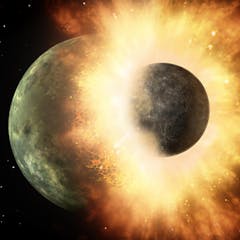
Articles on Earth science
Displaying 41 - 60 of 91 articles

A new array of seismometers provides a glimpse of what’s happening deep beneath this geologic fault. New data help explain why the north and south of the region are more seismically active than the middle.

Scientists have long thought most nitrogen in Earth’s ecosystems comes from the air, but new research shows it also is released as rocks weather. This could boost plant growth and help sequester carbon – but not fast enough to avert climate change, as some pundits have claimed.

Research suggests a new threat to life on Earth from the meteorite’s crash: Via seismic waves, the impact triggered massive undersea eruptions, as big as any ever seen in our planet’s history.

According to current forecasts, California has a 93 percent chance of an earthquake with magnitude 7 or greater occurring by 2045. Early warning systems, now in development, could limit casualties and damage.

A new study has found a way to predict eruptions at Mount Etna within two weeks.

While the Montecito, California mudslides took 20 lives, landslides kill far more people in developing countries. Tighter construction standards and early warning systems could help reduce their toll.

How do scientists predict volcanic eruptions? To do so with accuracy, they need to know the individual volcano and its history very well.

Mercury found in prehistoric rock bolsters the idea that volcanoes caused a mass extinction 200m years ago.

Why use satellites to study Earth’s climate? Researchers leading a new mission explain how images from space will help them analyze which parts of the Americas soak up the most carbon.

Almost half a million years ago a huge flood started breaking the apart the land bridge that joined England and France.

President Trump’s 2018 budget request cuts funding for NASA Earth observation research and cancels four missions. Weather forecasters, businesses, scientists and the armed forces rely on this data.

Far from being “politicised science”, as a Trump advisor has claimed, NASA’s satellite monitoring has been a crucial help in understanding the planet we live on.

New research suggests how asteroids may have helped create conditions for life on Earth. But we shouldn’t get too carried away with the idea – yet.

Amatrice’s still-standing ancient clocktower has become an iconic image from last week’s deadly earthquake. But it is not the only unusual survivor.

The Earth’s inner core is more than half a billion years older than previously thought, shows a study. The results could help us better understand the processes that shape the planet’s surface.

The House proposes slashing funding for earth science from NASA’s budget, yet this science is critical to understanding – and coping with – the dramatic effects of a warming Arctic around the world.

The moon might harbor bits of the Earth that blasted off our planet billions of years ago. These lunar time capsules could hold secrets about conditions here at home back when life was first emerging.

Stalagmites in Scottish preserve 3,000 years of climate history, suggesting human migration is linked to wet and dry periods.

The history of Earth Day reveals its true nature: a day about people, not really a celebration of an amazing planet – like a true birthday.

New experiments show that the asteroids that slammed into Earth and the moon more than 4 billion years ago were vaporised into a mist of iron. The findings, published in Nature Geoscience, suggest that…
